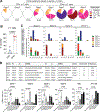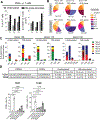NK-like CD8+ γδ T cells are expanded in persistent Mycobacterium tuberculosis infection
- PMID: 37000856
- PMCID: PMC10408713
- DOI: 10.1126/sciimmunol.ade3525
NK-like CD8+ γδ T cells are expanded in persistent Mycobacterium tuberculosis infection
Abstract
The response of gamma delta (γδ) T cells in the acute versus chronic phases of the same infection is unclear. How γδ T cells function in acute Mycobacterium tuberculosis (Mtb) infection is well characterized, but their response during persistent Mtb infection is not well understood, even though most infections with Mtb manifest as a chronic, clinically asymptomatic state. Here, we analyze peripheral blood γδ T cells from a South African adolescent cohort and show that a unique CD8+ γδ T cell subset with features of "memory inflation" expands in chronic Mtb infection. These cells are hyporesponsive to T cell receptor (TCR)-mediated signaling but, like NK cells, can mount robust CD16-mediated cytotoxic responses. These CD8+ γδ T cells comprise a highly focused TCR repertoire, with clonotypes that are Mycobacterium specific but not phosphoantigen reactive. Using multiparametric single-cell pseudo-time trajectory analysis, we identified the differentiation paths that these CD8+ γδ T cells follow to develop into effectors in this infection state. Last, we found that circulating CD8+ γδ T cells also expand in other chronic inflammatory conditions, including cardiovascular disease and cancer, suggesting that persistent antigenic exposure may drive similar γδ T cell effector programs and differentiation fates.
Conflict of interest statement
Figures






References
-
- Caccamo N, La Mendola C, Orlando V, Meraviglia S, Todaro M, Stassi G, Sireci G, Fournie JJ, Dieli F, Differentiation, phenotype, and function of interleukin-17-producing human Vgamma9Vdelta2 T cells. Blood 118, 129–138 (2011). - PubMed
-
- Papotto PH, Ribot JC, Silva-Santos B, IL-17(+) gammadelta T cells as kick-starters of inflammation. Nat Immunol 18, 604–611 (2017). - PubMed
Publication types
MeSH terms
Substances
Grants and funding
LinkOut - more resources
Full Text Sources
Medical
Research Materials

